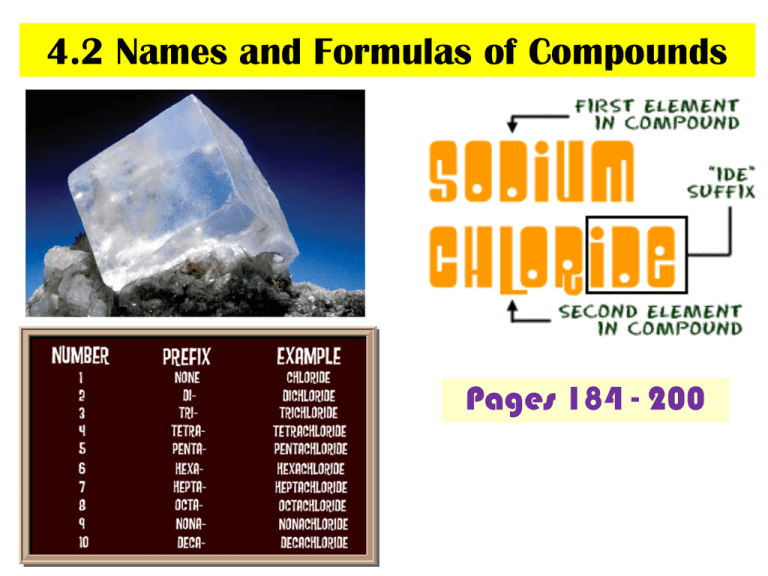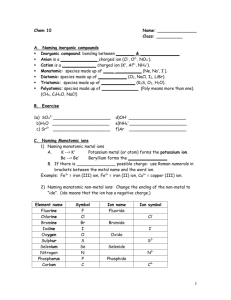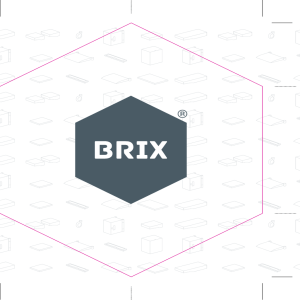4.2 Naming IONIC Compounds
advertisement

4.2 Names and Formulas of Compounds Pages 184 - 200 SHOWBIE App The class code for your Science 10 class is: BDDYG Evernote App The class code for your Science 10 class is: BDDYG QUICK REVIEW OF ELEMENTS, IONS, and COMPOUNDS The Chemical Elements Rules for Naming and Writing: 1.) Each element has a name and a symbol NAME SYMBOL Gold Au The Chemical Elements Rules for Naming and Writing: 1.) Each element has a name and a symbol NAME SYMBOL Gold Au Silver Ag The Chemical Elements Rules for Naming and Writing: 1.) Each element has a name and a symbol NAME SYMBOL Gold Au Silver Ag Copper Cu The Chemical Elements Rules for Naming and Writing: 1.) Each element has a name and a symbol NAME SYMBOL Gold Au Silver Ag Copper Cu Sulphur S The Chemical Elements Rules for Naming and Writing: 2.) The first letter in the symbol is always in the upper case, the second (if present) is always in the lower case The Chemical Elements Rules for Naming and Writing: 2.) The first letter in the symbol is always in the upper case, the second (if present) is always in the lower case Naming and Writing Formulae of Ionic Compounds • A compound made up of ions of a metal AND a non-metal or a polyatomic ion • A compound in which a metal and a nonmetal/polyatomic ion donate and accept electrons • The net (overall) charge of the ionic compound is 0 • i.e. the compound is NEUTRAL IONIC COMPOUNDS Formed by an attraction of positively charged ion and negatively charged ion Chemical formula Naming of IONIC COMPOUNDS metal UNIVALENT nonmetal MULTIVALENT metal polyatomic ion polyatomic ion polyatomic ion Naming of IONIC COMPOUNDS metal UNIVALENT nonmetal MULTIVALENT Chemical names of Ionic Compounds 1. Have always two parts: one for a metal ion (Ca2+) and one for non metal ion (Cl-) 1. Name the metal ion (a positive ion) 2. Name the non-metal ion (a negative ion) 3. Put 1 + 2 together There Are Two Types Of Metal Ions metal More than one charge UNIVALENT only one charge MULTIVALENT There Are Two Types Of Metal Ions If a metal has only one charge METAL NAME METAL SYMBOL METAL ION NAME METAL ION SYMBOL UNIVALENT METAL ION (cation) If a metal has only one charge METAL NAME METAL SYMBOL METAL ION NAME METAL ION SYMBOL To name a cation... Use only the name of a metal METAL SYMBOL Ca METAL NAME calcium METAL ION SYMBOL Ca2+ METAL ION NAME calcium K potassium K+ potassium Mg Ag magnesium silver Mg2+ Ag+ magnesium silver Li Al Ba lithium aluminum barium Li+ Al3+ Ba2+ lithium aluminum barium Cs cesium Cs+ cesium MULTIVALENT METAL ION (cations) If a metal has more than one charge… To name a MULTIVALENT ION 1. 2. Name exactly like an Univalent Metal Ion, but... You MUST indicate the charge by a Roman numeral, in parentheses, immediately following the name of the metal ion Fe2+ = iron (II) (“iron two”) Fe3+ = iron (III) (“iron three”) MULTIVALENT METALS (cations) METAL ION SYMBOL METAL ION NAME USING THE STOCK NAMING SYSTEM A NAME USING THE CLASSICAL SYSTEM Cu2+ Au+ Fe2+ Pb2+ Sn2+ Au3+ Co2+ Hg2+ copper (ll) gold (l) iron (ll) lead (ll) tin (ll) gold (lll) cobalt (ll) mercury (ll) cupric aurous ferrous plumbous stannous auric cobaltous mercuric Chemical names of Ionic Compounds 1. Have always two parts: one for a metal ion (Ca2+) and one for non metal ion (Cl-) 1. Name the metal ion (a positive ion) 2. Name the non-metal ion (a negative ion) 3. Put 1 + 2 together NON – METAL IONS (anions) - Omit the original ending of the element’s name and add an “ide” ending - “ide” ending means that the ion has a negative charge For example: chlorine chloride NON – METAL IONS (anions) ELEMENT SYMBOL ELEMENT NAME ION SYMBOL ION NAME F fluorine F- fluoride Cl chlorine Cl- chloride Br bromine Br- bromide I iodine I- iodide O oxygen O2- oxide S sulphur S2- sulphide N nitrogen N3- nitride P phosphorus P3- phosphide Chemical names of Ionic Compounds 1. Have always two parts: one for a metal ion (Ca2+) and one for non metal ion (Cl-) 1. Name the metal ion (a positive ion) 2. Name the non-metal ion (a negative ion) 3. Put 1 + 2 together Example 1: zinc chloride 1. Simply name the ions one after the another! (Remember that the first ion has a positive charge (metal) and the second ion has a negative charge (non - metal) Example 2: calcium oxide If the first ion (metal) is a multivalent metal ion, use the second ion’s charge to determine the first ion’s name Fe2+ = iron (II) (“iron two”) Fe3+ = iron (III) (“iron three”) Example 2: lead (II) OR lead (IV) How will you find out? Example 2: lead (II) OR lead (IV) Look at the charge on the second ion (OXYGEN)! Example 2: lead (II) OR lead (IV) You know: 1. The compound is neutral (overall 0 charge), so the charge of the first ion (lead) MUST EQUAL the charge on the second ion (oxide) Example 2: lead (II) OR One oxide’s (O2-) charge is: We have two oxides: lead (IV) So, the charge of the two oxides is twice as much: Example 2: lead (II) OR lead (IV) The charge on the positive ion then MUST be to balance the negative charge of -4 +4 Example 2: lead (II) OR lead (IV) The correct ion is then: Example 2: lead (II) OR lead (IV) And the name for this compound is: lead (IV) oxide Writing Formulas of Ionic Compounds potassium oxide The positive charge MUST ALWAYS balance the negative charge in the ionic compound Method #1 potassium oxide 1. Write the formulas + charges for the metal ion (cation) and the nonmetal ion (anion)(or a polyatomic ion) + K and 2O Method #1 potassium oxide 2. Balance the charges, so the overall charge of the compound = 0 + K and 2O Method #1 potassium oxide 2. Balance the charges, so the overall charge of the compound = 0 + K and 2O Method #1 potassium oxide 2. Balance the charges, so the overall charge of the compound = 0 + K and + K and 2O Method #1 potassium oxide 2. Balance the charges, so the overall charge of the compound = 0 + K and + K and 2O Method #2 = CROSSOVER METHOD potassium oxide Method #2 = CROSSOVER METHOD potassium oxide 1+ 2- K and O Method #2 = CROSSOVER METHOD potassium oxide 1+ 2- K and O Method #2 = CROSSOVER METHOD potassium oxide 1+ 2- K and O Method #1 vs Method #2 titanium(iv) oxide If you have a name of an ionic compound containing a multivalent metal, Fe2+ = iron (II) (“iron two”) Fe3+ = iron (III) (“iron three”) To name a MULTIVALENT ION Name it exactly like you do with Univalent Metal Ions, but... 2. You MUST indicated the charge by a Roman numeral, in parentheses, immediately following the name of the metal ion 1. Fe2+ = iron (II) (“iron two”) Fe3+ = iron (III) (“iron three”) 1. Identify each ion and its charge 2. Use A CROSSOVER METHOD (or Method #1) to balance the charges on each ion so you have ZERO (0) overall charge!! iron(III)sulphide 3+ Fe and 2S TITLE of a TABLE REACTION Observation after mixing Observation of a solid produced Observation of the flame test HOMEWORK – make a table of values Naming of IONIC COMPOUNDS metal UNIVALENT nonmetal MULTIVALENT metal polyatomic ion polyatomic ion polyatomic ion Naming of IONIC COMPOUNDS metal UNIVALENT nonmetal MULTIVALENT metal polyatomic ion polyatomic ion polyatomic ion Polyatomic Ions • A polyatomic ion contains more than one atom Polyatomic Ions You have to memorize the names, formulae, and charges of these polyatomic ions + other ones (see the worksheet): Name Formula and charge Name Formula and charge carbonate chromate dichromate sulphate sulphite nitrate nitrite ammonium CO32CrO42Cr2O72SO42SO32NO3NO2NH4+ acetate permanganate perchlorate oxalate cyanide chlorite phosphate hydroxide H3C2O2MnO4ClO4C2O42- CNClO2- PO43OH- 1. Identify each ion and its charge 2. Use A CROSSOVER METHOD (or Method #1) to balance the charges on each ion so you have ZERO (0) overall charge!! iron(III)sulphate 3+ Fe and SO4 2- lead (II) OR lead (IV) How will you find out? lead (II) OR lead (IV) Look at the charge on the hydroxide ion! 1. The compound is neutral (overall charge = 0), so... 2. The charge of the metal ion (lead) = the charge on the polyatomic ion(s) (hydroxide) lead (II) OR lead (IV) hydroxide’s charge is: We have two hydroxides : lead (II) OR lead (IV) hydroxide’s charge is: We have two hydroxides : lead (II) OR lead (IV) hydroxide’s charge is: We have two hydroxides : lead (II) OR lead (IV) 2+ to balance the hydroxide ions’ charge of 2The charge on lead ion then MUST be hydroxide’s charge is: We have two hydroxides : lead (II) OR lead (IV) 2+ to balance the hydroxide ions’ charge of 2The charge on lead ion then MUST be hydroxide’s charge is: We have two hydroxides : lead (II) OR lead (IV) lead(II)hydroxide Naming and Writing Formulas of Covalent Compounds (molecules) COVALENT COMPOUNDS (molecules): contain a non metal(s) bonding to a non metal(s) 1. because non-metals combine in more than one ratio, we must use prefixes to indicate the number of atoms of each element in the formula. 2. if the prefix is followed by a vowel, the final "a" or "o" is dropped (not for DI- or TRI-) 3. EXCEPTION: the prefix mono is omitted for the first element only PREFIX Number of atoms mono 1 di 2 tri 3 tetra 4 penta 5 hexa 6 hepta 7 octa 8 nona 9 deca 10 Naming and Writing Formulas of Covalent Compounds (molecules) PREFIX Number of atoms mono 1 di 2 tri 3 tetra 4 penta 5 hexa 6 hepta 7 octa 8 nona 9 deca 10 EXAMPLES: Showbie – 4 assignments – see the due dates TBD

